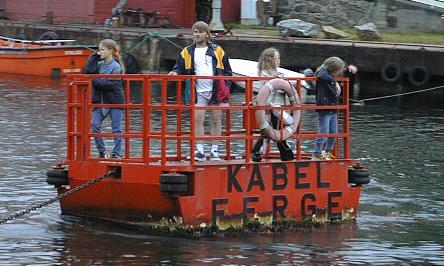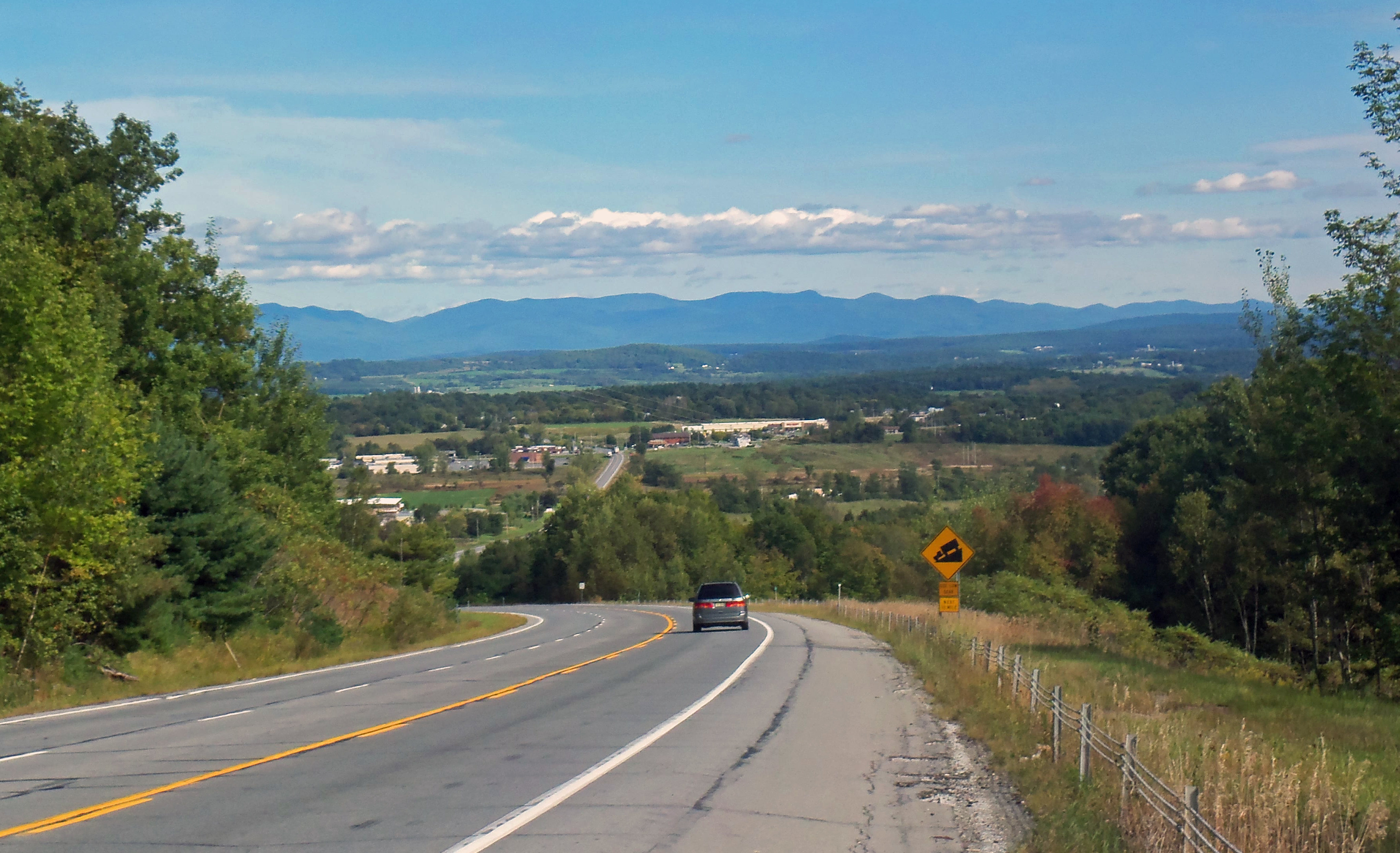|
Fort Ticonderoga–Larrabees Point Ferry
The Fort Ticonderoga Ferry is a cable ferry crossing Lake Champlain between Ticonderoga, New York, and Shoreham, Vermont. It connects the New York and Vermont segments of State Route 74 The ferry can carry up to 18 cars and has a weight limit of 15 tons. The ferry operates seasonally, from May to October. The crossing takes seven minutes, and there are three crossings every hour. Cars are charged $12 one way, or $20 for a round trip. The ferry has been regularly operating in some form since 1759, but regular operation only began in 1823. The ferry uses a cable system consisting of two steel cables aligned in parallel. The ferry did not operate between 2020 and 2022 due to both concerns over the COVID-19 pandemic The COVID-19 pandemic (also known as the coronavirus pandemic and COVID pandemic), caused by severe acute respiratory syndrome coronavirus 2 (SARS-CoV-2), began with an disease outbreak, outbreak of COVID-19 in Wuhan, China, in December ..., and litigation b ... [...More Info...] [...Related Items...] OR: [Wikipedia] [Google] [Baidu] |
Shoreham, Vermont
Shoreham is a New England town, town in Addison County, Vermont, United States. The population was 1,260 at the 2020 United States Census, 2020 census. Geography Shoreham is located in western Addison County along the shore of Lake Champlain. The western boundary of the town, which follows the center of the lake, is also the state border with New York (state), New York. Neighboring Vermont towns are Bridport, Vermont, Bridport to the north, Cornwall, Vermont, Cornwall and Whiting, Vermont, Whiting to the east, and Orwell, Vermont, Orwell to the south. Ticonderoga, New York, is to the west across Lake Champlain, accessible in the summertime by the Ticonderoga–Larrabees Point Ferry, a diesel-powered cable ferry. According to the United States Census Bureau, Shoreham has a total area of , of which is land and , or 6.36%, is water. The village (Vermont), village of Shoreham is located at the intersection of Vermont Route 22A and Vermont Route 74. Demographics As of the census ... [...More Info...] [...Related Items...] OR: [Wikipedia] [Google] [Baidu] |
Ticonderoga, New York
Ticonderoga () is a Administrative divisions of New York#Town, town in Essex County, New York, Essex County, New York (state), New York, United States. The population was 5,042 at the 2010 census. The name comes from the Mohawk language, Mohawk ''tekontaró:ken'', meaning "it is at the junction of two waterways". The Town of Ticonderoga is in the southeastern corner of the county and is south of Plattsburgh, New York, Plattsburgh. History In the 17th century, French explorers such as Samuel de Champlain encountered the area. The town was on the direct route, utilizing rivers and two long lakes, between New York City to the south and the French settlement of Montreal to the north. The town was the setting for historic battles and maneuvers during both the French and Indian War and the American Revolutionary War. Fort Ticonderoga, constructed by the French, who called it ''Fort Carillon'', in the 1750s, marked the location of an important portage between the two lakes, Lake Geor ... [...More Info...] [...Related Items...] OR: [Wikipedia] [Google] [Baidu] |
Lake Champlain
Lake Champlain ( ; , ) is a natural freshwater lake in North America. It mostly lies between the U.S. states of New York (state), New York and Vermont, but also extends north into the Canadian province of Quebec. The cities of Burlington, Vermont and Plattsburgh, New York are the largest settlements on the lake, and towards the south lies the historic Fort Ticonderoga in New York. The Quebec portion is in the Regional county municipality, regional county municipalities of Le Haut-Richelieu Regional County Municipality, Quebec, Le Haut-Richelieu and Brome-Missisquoi Regional County Municipality, Brome-Missisquoi. There are a number of islands in the lake; the largest include Grand Isle (island), Grand Isle, Isle La Motte and North Hero: all part of Grand Isle County, Vermont. Because of Lake Champlain's connections both to the St. Lawrence Seaway via the Richelieu River, and to the Hudson River via the Champlain Canal, Lake Champlain is sometimes referred to as "The Sixth Great ... [...More Info...] [...Related Items...] OR: [Wikipedia] [Google] [Baidu] |
Cable Ferry
A cable ferry (including the types chain ferry, swing ferry, floating bridge, or punt) is a ferry that is guided (and in many cases propelled) across a river or large body of water by cables connected to both shores. Early cable ferries often used either rope or steel chains, with the latter resulting in the alternative name of chain ferry. Both of these were largely replaced by wire cable by the late 19th century. Types Cable ferries can be typified by their size and construction, their usage (passenger, animal, vehicle) and requirements (length of crossing, amount of other shipping), their cables (wire rope, chain, or both), and their propulsion (water current, engine, manual). The choice of cable depends partially on the requirements of the crossing but also on the historical context. For example, the numerous cable ferries across Australian and Canadian rivers seem to use wire rope exclusively, whereas the older crossings across busy tidal rivers in England all use chain. ... [...More Info...] [...Related Items...] OR: [Wikipedia] [Google] [Baidu] |
State Route 74 (New York–Vermont)
New York State Route 74 (NY 74) and Vermont Route 74 (VT 74) are state highways in the northeastern United States, connected by one of the last remaining Cable ferry, cable ferries in North America. Together they extend for through Essex County, New York, and Addison County, Vermont. NY 74 begins at exit 28 off Interstate 87 (New York), Interstate 87 (I-87) in Schroon, New York, the hamlet of Severance in the Adirondack Mountains region of the northern part of New York State. It extends to the western shore of Lake Champlain in Ticonderoga, New York, Ticonderoga. There, the seasonal Fort Ticonderoga–Larrabees Point Ferry carries cars across the state border into Vermont, where VT 74 starts at the lake's eastern shore and terminates later at a junction with Vermont Route 30, VT 30 in the town of Cornwall, Vermont, Cornwall. The ferry connecting the two highways, predating both NY 74 and VT 74, began operation in 1759 on ... [...More Info...] [...Related Items...] OR: [Wikipedia] [Google] [Baidu] |
COVID-19 Pandemic
The COVID-19 pandemic (also known as the coronavirus pandemic and COVID pandemic), caused by severe acute respiratory syndrome coronavirus 2 (SARS-CoV-2), began with an disease outbreak, outbreak of COVID-19 in Wuhan, China, in December 2019. Soon after, it spread to other areas of Asia, and COVID-19 pandemic by country and territory, then worldwide in early 2020. The World Health Organization (WHO) declared the outbreak a public health emergency of international concern (PHEIC) on 30 January 2020, and assessed the outbreak as having become a pandemic on 11 March. COVID-19 symptoms range from asymptomatic to deadly, but most commonly include fever, sore throat, nocturnal cough, and fatigue. Transmission of COVID-19, Transmission of the virus is often airborne transmission, through airborne particles. Mutations have variants of SARS-CoV-2, produced many strains (variants) with varying degrees of infectivity and virulence. COVID-19 vaccines were developed rapidly and deplo ... [...More Info...] [...Related Items...] OR: [Wikipedia] [Google] [Baidu] |
Ferries Of Vermont
A ferry is a boat or ship that transports passengers, and occasionally vehicles and cargo, across a body of water. A small passenger ferry with multiple stops, like those in Venice, Italy, is sometimes referred to as a water taxi or water bus. Ferries form a part of the public transport systems of many waterside cities and islands, allowing direct transit between points at a capital cost much lower than bridges or tunnels. Ship connections of much larger distances (such as over long distances in water bodies like the Baltic Sea) may also be called ferry services, and many carry vehicles. History The profession of the ferryman is embodied in Greek mythology in Charon, the boatman who transported souls across the River Styx to the Underworld. Speculation that a pair of oxen propelled a ship having a water wheel can be found in 4th century Roman literature "''Anonymus De Rebus Bellicis''". Though impractical, there is no reason why it could not work and such a ferry, modified by ... [...More Info...] [...Related Items...] OR: [Wikipedia] [Google] [Baidu] |
Cable Ferries In The United States
Cable may refer to: Mechanical * Nautical cable, an assembly of three or more ropes woven against the weave of the ropes, rendering it virtually waterproof * Wire rope, a type of rope that consists of several strands of metal wire laid into a helix ** Arresting cable, part of a system used to rapidly decelerate an aircraft as it lands ** Bowden cable, a mechanical cable for transmitting forces * Rope generally, especially a thick, heavy ("cable laid") variety Transmission * Electrical cable, an assembly of one or more wires which may be insulated, used for transmission of electrical power or signals ** Coaxial cable, an electrical cable comprising an inner conductor surrounded by a flexible, tubular insulating layer, coated or surrounded by a tubular conducting shield ** Power cable, a cable used to transmit electrical power ** Submarine communications cable, a cable laid on the sea bed to carry telecommunication signals between land-based stations * Fiber-optic cable, a cable co ... [...More Info...] [...Related Items...] OR: [Wikipedia] [Google] [Baidu] |



